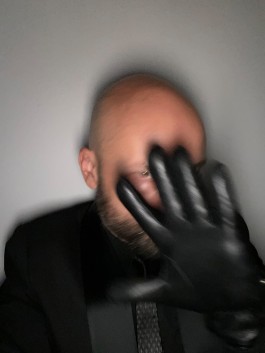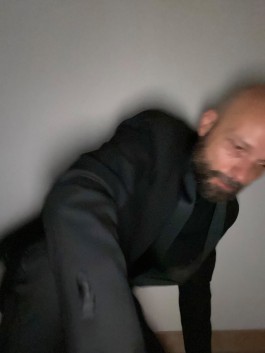SPRACHE ALS RÄUMLICHE PSYCHOLOGIE
Seit über zwanzig Jahren bewege ich mich an der Schnittstelle von Raum, Wahrnehmung und Bedeutung. Meine Arbeit untersucht die psychologische Wirkung von Sprache, wenn sie physisch und räumlich verankert wird – ob als großformatige Intervention im öffentlichen Raum oder als konzentrierte Setzung in einem Innenraum. Mich interessiert, wie Worte nicht nur gelesen, sondern betreten, umgangen, erlebt werden können.
Sprache im Raum wirkt doppelt: Sie adressiert das Individuum unmittelbar – als persönliche Botschaft, die im Kopf und Körper nachhallt – und sie formt zugleich den kollektiven Deutungsraum einer Gemeinschaft. Jede Lesung ist subjektiv, jede Sichtbarkeit jedoch öffentlich.
Meine Arbeiten verbinden reduzierte, grafisch prägnante Typografie – oft in einer konstruierten, geometrischen Formensprache – mit kurzen, präzisen Aussagen. Diese Texte sind keine bloßen Informationsfragmente, sondern psychologische Auslöser: Sie können irritieren, bestätigen, provozieren oder ermächtigen. Manche spiegeln Machtmechanismen, andere öffnen Möglichkeitsräume für Selbstbestimmung und Selbstwahrnehmung.
Der Raum selbst ist dabei nicht neutral. Er ist Bühne, Verstärker und Filter zugleich. Im öffentlichen Kontext – etwa auf Fassaden, in Leuchtkästen, auf Fahnen oder architektonischen Flächen – werden die Aussagen Teil des Alltagsflusses, zwischen Werbung, Architektur und Stadtgeräusch. Sie treten in Konkurrenz zu anderen Botschaften, aber auch in einen Dialog mit dem kollektiven Bewusstsein. Im Innenraum – ob Galerie, institutioneller Raum oder privater Kontext – verschiebt sich die Wahrnehmung: Die gleiche Botschaft kann intimer, analytischer oder konfrontativer wirken.
Ziel meiner Arbeit ist es, diese Doppelwirkung bewusst zu inszenieren. Die Botschaften sind nie nur Behauptung, sondern Einladung zur Reflexion – sowohl über die eigene Position als auch über die sozialen und räumlichen Strukturen, die uns alle prägen. Ob im Stadtraum oder im geschlossenen Raum: Es geht um die Frage, wie Sprache unsere Lebensräume formt – und wie wir sie durch bewusste Wahrnehmung zurückerobern können.
LANGUAGE AS SPATIAL PSYCHOLOGY
For more than twenty years, I have been working at the intersection of space, perception, and meaning. My practice investigates the psychological impact of language when it is anchored physically and spatially – whether as a large-scale intervention in public space or as a concentrated insertion within an interior. I am interested in how words are not only read, but entered, circled, and experienced.
Language in space operates on two levels: it addresses the individual directly – as a personal message resonating in mind and body – while simultaneously shaping the collective field of interpretation shared by a community. Every reading is subjective, yet every visibility is public.
My works combine reduced, graphically striking typography – often based on a constructed, geometric formal language – with short, precise statements. These texts are not mere fragments of information, but psychological triggers: they can irritate, affirm, provoke, or empower. Some reflect mechanisms of power, while others open possibilities for self-determination and self-perception.
The space itself is never neutral. It is stage, amplifier, and filter at once. In public contexts – on façades, in light boxes, on flags, or across architectural surfaces – the statements become part of the everyday flow, woven into the fabric of advertising, architecture, and urban noise. They compete with other messages, yet also enter into dialogue with the collective consciousness. In interior spaces – whether galleries, institutions, or private contexts – perception shifts: the same statement may appear more intimate, analytical, or confrontational.
The aim of my work is to stage this double effect consciously. The messages are never just assertions, but invitations to reflect – both on one’s own position and on the social and spatial structures that shape us all. Whether in urban space or in enclosed environments, the question remains: how does language shape our living spaces – and how can we reclaim them through conscious perception?






CHRISTOPH HOIDN
CREATIVE DIRECTOR, ARTIST & FOUNDER
VITA
1977 HELLO WORLD!
1997–2001 STUDIES COMMUNICATION DESIGN
UNIVERSITY OF APPLIED SCIENCE NUREMBERG
WORKS AND LIVES IN MUNICH
FOUNDER OF OH LA LAQUA www.ohlalaqua.com
DESIGN DIRECTOR AT BLACKSPACE www.blackspace.com
IMPRESSUM DATENSCHUTZERKLÄRUNG
© CHRISTOPH HOIDN